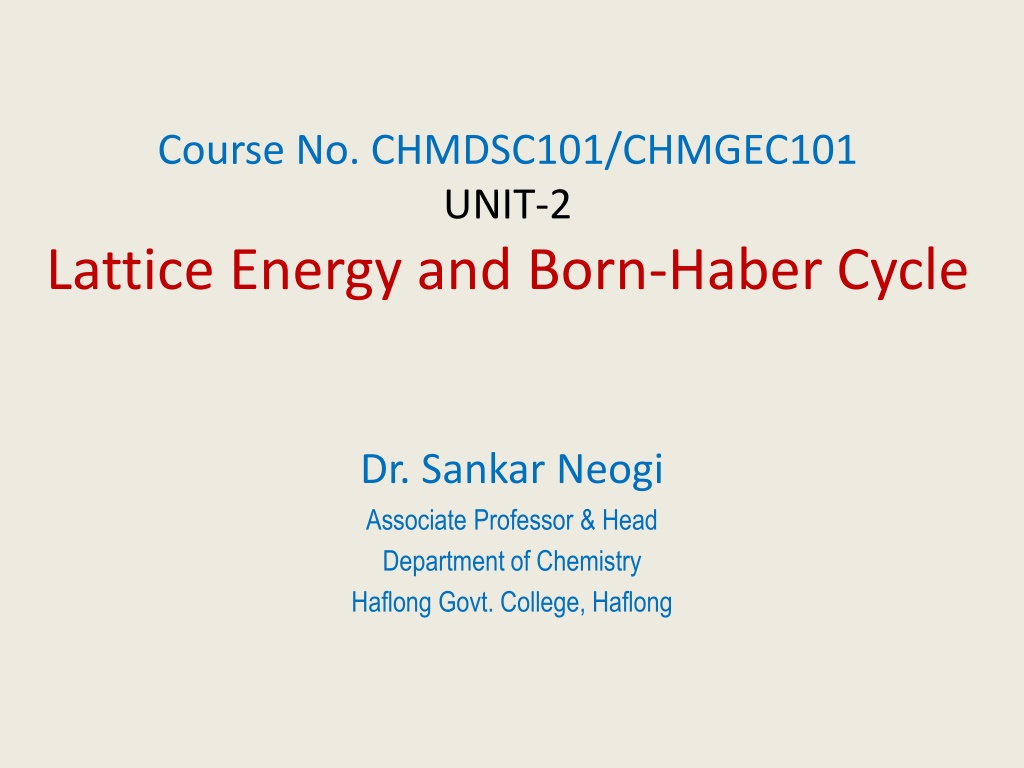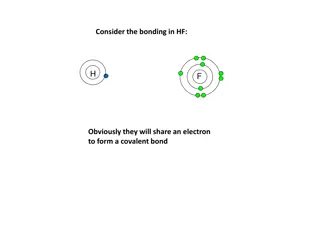Understanding Ionic Bonding and Lattice Energy in Chemistry
Chemical bonds play a crucial role in holding atoms together in molecules. This course explores the concept of chemical bonding, focusing on ionic bonds and lattice energy. Topics covered include the different types of chemical bonds, such as electrovalent and coordinate bonds, as well as the models of chemical bonding. The course delves into the formation of ionic compounds through electron transfer and discusses crystal structures in detail. Through a comprehensive overview, students will gain insights into the fundamentals of chemical bonding and its applications in understanding the properties of materials.
Download Presentation

Please find below an Image/Link to download the presentation.
The content on the website is provided AS IS for your information and personal use only. It may not be sold, licensed, or shared on other websites without obtaining consent from the author. Download presentation by click this link. If you encounter any issues during the download, it is possible that the publisher has removed the file from their server.
E N D
Presentation Transcript
Course No. CHMDSC101/CHMGEC101 UNIT-2 Lattice Energy and Born-Haber Cycle Dr. Sankar Neogi Associate Professor & Head Department of Chemistry Haflong Govt. College, Haflong
Overview Chemical Bond Ionic Bond Crystal Ionic Crystal Types of Ionic Crystal Lattice Energy Born-Haber Cycle
Chemical Bond A CHEMICAL BOND IS DEFINED AS A FORCE OF ATTRACTRATION WHICH HOLDS TOGETHER THE CONSTITUTENT ATOMS IN A MOLECULE
Types of Chemical Bond Three main types of Chemical bonds. Electrovalent bond or Ionic bond involves the transfer of electrons and is usually observed when a metal bonds to a nonmetal.
Contn.. Covalent electrons and is usually observed when a nonmetal bonds to a nonmetal. bond involves the sharing of Coordinate bond or Dative bond involves the transfer of electrons and occurs when a nonmetal bonds to another nonmetal.
The Ionic Bonding Model An ionic bond is formed when a metal transfers electrons to a nonmetal to form ions, which attract each other to give a solid compound. The total number of electrons lost by the metal atom(s) equals the total number of electrons gained by the nonmetal atoms.
Three ways to depict electron transfer in the formation of Li+and F-. Electron configurations Li 1s22s1+ F 1s22p5 Li+1s2+ F-1s22s22p6 Orbital diagrams Li Li+ + 1s 2s 2p 1s 2s 2p F- F 1s 2s 2p 1s 2s 2p Lewis electron-dot symbols - Li+ + Li F F
Crystal Structures Atoms (and later ions) will be viewed as hard spheres. In the case of pure metals, the packing pattern often provides the greatest spatial efficiency (closest packing). Ionic crystals can often be viewed as a close-packed arrangement of the larger ion, with the smaller ion placed in the holes of the structure.
Unit Cells A unit cell of the crystal is an imaginary parallel-sided region from which the entire crystal can be built up. Usually the smallest unit cell which exhibits the greatest symmetry is chosen. If repeated (translated) in 3 dimensions, the entire crystal is recreated.
Ionic Crystals Ionic Crystals in which the units are positively and negatively charged ions occupy the lattice points. Ionic Crystals are of the type AX (e.g NaCl, LiF, etc.), AX2(CaCl2) or A2X (Na2S)
Lattice Energy The Lattice energy (U) of an ionic crystal is defined as the amount of energy released when cations and anions in their gaseous states are brought from infinity to their respective lattice sites in a crystal to form one mole of the ionic crystal A+(g) + B-(g) UA+B-(s); U=Latice energy
Periodic Trends in Lattice Energy Lattice energy is the energy required to separate 1 mol of an ionic solid into gaseous ions. Lattice energy is a measure of the strength of the ionic bond. Coloumb s Law charge A x charge B distance Electrostatic energy cation charge x anion charge cation radius + anion radius Holattice Electrostatic energy
Periodic Trends in Lattice Energy Lattice energy is affected by ionic size and ionic charge. As ionic size increases, lattice energy decreases. Lattice energy therefore decreases down a group on the periodic table. As ionic charge increases, lattice energy increases.
Born-Haber Cycle Direct experimental determination of lattice energies is not so easy Lattice energies are determined indirectly with the help of a thermo-chemical cyclic process known as Born-Haber cycle
Contn.. For a reaction such as Na(s) + Cl2(g) NaCl(s) we want to decide if the compound will be stable as an ionic salt. The customary way of doing this is to use a thermodynamic cycle (an application of Hess s Law). In this case the cycle is known as the Born-Haber Cycle
+ Na+(g) Cl-(g) IE EA Na(g) Cl(g) Hsub BDE Lattice Energy (U) Hf Na(s) + Cl2(g) NaCl(s)
Contn.. By knowing the value of all the other terms, including Hf, then Lattice energy (U)can be calculate from the equation U = Hf ( Hsub + IE + BDE + EA) Without the value of Hf , U can be estimated by several methods the Born equation the Born-Meyer equation the Kapustinski equation























